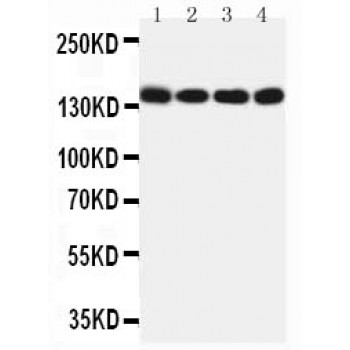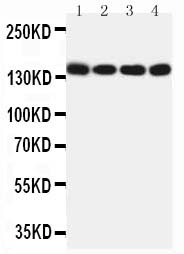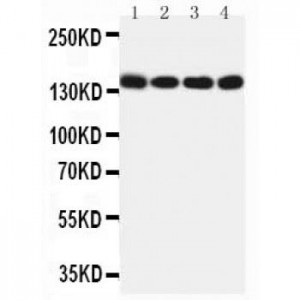More info
Overview
Long Name | Antibody Type | Antibody Isotype | Host | Species Reactivity | Validated Applications | Purification |
| c-mer proto-oncogene tyrosine kinase | Polyclonal | IgG | Rabbit | Human, Mouse, Rat | WB | Immunogen affinity purified. |
Immunogen | ||||||
| A synthetic peptide corresponding to a sequence at the N-terminus of human MERTK(132-148aa KDGKELLGAHHAITQFY), different from the related mouse and rat sequences by one amino acid. | ||||||
Properties
Form | Lyophilized |
Size | 100 µg/vial |
Contents | Antibody is lyophilized with 5 mg BSA, 0.9 mg NaCl, 0.2 mg Na2HPO4, 0.05 mg Thimerosal and 0.05 mg NaN3. *carrier free antibody available upon request. |
Concentration | Reconstitute with 0.2 mL sterile dH2O (500 µg/ml final concentration). |
Storage | At -20 °C for 12 months, as supplied. Store reconstituted antibody at 2-8 °C for one month. For long-term storage, aliquot and store at -20 °C. Avoid repeated freezing and thawing. |
Additional Information Regarding the Antigen
Gene | MERTK |
Protein | Tyrosine-protein kinase Mer |
Uniprot ID | Q12866 |
Function | Receptor tyrosine kinase that transduces signals from the extracellular matrix into the cytoplasm by binding to several ligands including LGALS3, TUB, TULP1 or GAS6. Regulates many physiological processes including cell survival, migration, differentiation, and phagocytosis of apoptotic cells (efferocytosis). Ligand binding at the cell surface induces autophosphorylation of MERTK on its intracellular domain that provides docking sites for downstream signaling molecules. Following activation by ligand, interacts with GRB2 or PLCG2 and induces phosphorylation of MAPK1, MAPK2, FAK/PTK2 or RAC1. MERTK signaling plays a role in various processes such as macrophage clearance of apoptotic cells, platelet aggregation, cytoskeleton reorganization and engulfment. Functions in the retinal pigment epithelium (RPE) as a regulator of rod outer segments fragments phagocytosis. Plays also an important role in inhibition of Toll- like receptors (TLRs)-mediated innate immune response by activating STAT1, which selectively induces production of suppressors of cytokine signaling SOCS1 and SOCS3. |
Tissue Specificity | Not expressed in normal B- and T-lymphocytes but is expressed in numerous neoplastic B- and T-cell lines. Highly expressed in testis, ovary, prostate, lung, and kidney, with lower expression in spleen, small intestine, colon, and liver. |
Sub-cellular localization | Membrane ; Single-pass type I membrane protein . |
Sequence Similarities | Belongs to the protein kinase superfamily. Tyr protein kinase family. AXL/UFO subfamily. |
Aliases | c MER antibody|c mer proto oncogene tyrosine kinase antibody|c-mer antibody|cMER antibody|cmer protooncogene tyrosine kinase antibody|Eyk antibody|MER antibody|MER receptor tyrosine kinase antibody|MERK antibody|MERPEN antibody|Mertk antibody|MERTK c-mer proto-oncogene tyrosine kinase antibody|MGC133349 antibody|nmf12 antibody|Nyk antibody|Proto oncogene tyrosine protein kinase MER antibody|Proto oncogene tyrosine protein kinase MER precursor antibody|Proto-oncogene c-Mer antibody|Receptor tyrosine kinase MerTK antibody|RP38 antibody|STK kinase antibody||Tyrosine-protein kinase Mer antibody |
Application Details
| Application | Concentration* | Species | Validated Using** |
| Western blot | 0.1-0.5μg/ml | Human Mouse, Rat | AssaySolutio's ECL kit |
AssaySolution recommends Rabbit Chemiluminescent WB Detection Kit (AKIT001B) for Western blot. *Blocking peptide can be purchased at $65. Contact us for more information

Anti-MERTK antibody, ASA-B1264, All Western blotting
All lanes: Anti-MERTK(ASA-B1264) at 0.5ug/ml
Lane 1: HELA Whole Cell Lysate at 40ug
Lane 2: A549 Whole Cell Lysate at 40ug
Lane 3: NIH Whole Cell Lysate at 40ug
Lane 4: 22RV1 Whole Cell Lysate at 40ug
Predicted bind size: 110KD
Observed bind size: 140KD
All lanes: Anti-MERTK(ASA-B1264) at 0.5ug/ml
Lane 1: HELA Whole Cell Lysate at 40ug
Lane 2: A549 Whole Cell Lysate at 40ug
Lane 3: NIH Whole Cell Lysate at 40ug
Lane 4: 22RV1 Whole Cell Lysate at 40ug
Predicted bind size: 110KD
Observed bind size: 140KD



